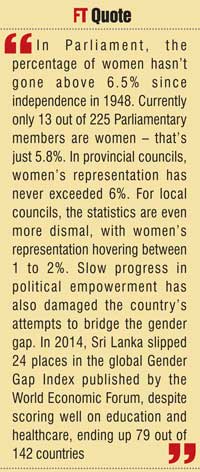Wednesday Nov 26, 2025
Wednesday Nov 26, 2025
Saturday, 6 June 2015 00:00 - - {{hitsCtrl.values.hits}}
Chandrika Bandaranaike Kumaratunga became Sri Lanka’s first woman President in 1994 and completed two terms in power
In 1960, Sirimavo Bandaranaike was appointed as the island’s sixth Prime Minister, the first woman in the role
By Uditha Jayasinghe
Wall Street Journal: Sri Lanka elected the world’s first female Prime Minister in 1960 but four decades later the island nation is still struggling to achieve equal representation for women in politics.
Fresh electoral reforms, which include combining the proportional representation and first-past-the-post system, promised by its new Government could be the answer to the female shortfall.
Though women’s rights campaigners say the changes are not legally binding and fail to introduce a quota system, which they argue is essential to achieve equality in Parliament.
In 1931, Sri Lanka became the first country in Asia to give women the vote.
By 1960, Sirimavo Bandaranaike was appointed as the island’s sixth Prime Minister, the first woman in the role. She served three terms and retired from office at the age of 84. Her daughter, Chandrika Bandaranaike Kumaratunga, became Sri Lanka’s first woman President in 1994 and completed two terms in power. After blazing a trail, albeit a dynastically-driven one, female representation in wider Sri Lankan politics has remained abysmally low, say rights advocates.
In Parliament, the percentage of women hasn’t gone above 6.5% since independence in 1948. Currently only 13 out of 225 Parliamentary members are women – that’s just 5.8%.
In provincial councils, women’s representation has never exceeded 6%. For local councils, the statistics are even more dismal, with women’s representation hovering between 1 to 2%.
Slow progress in political empowerment has also damaged the country’s attempts to bridge the gender gap. In 2014, Sri Lanka slipped 24 places in the global Gender Gap Index published by the World Economic Forum, despite scoring well on education and healthcare, ending up 79 out of 142 countries.
 “Transformation of the current political culture is crucial to create an environment in which women can equally run for political office,” said gender rights activist Kumudini Samuels and Director of Sri Lanka’s Women and Media Collective.
“Transformation of the current political culture is crucial to create an environment in which women can equally run for political office,” said gender rights activist Kumudini Samuels and Director of Sri Lanka’s Women and Media Collective.
Legally binding mandatory provisions for elected bodies and political parties that include compulsory nominations, closed lists and reserved seats have been successfully used worldwide to increase women representation, she argues.
Over a 100 countries have used quota systems to raise political empowerment, including Sri Lanka’s neighbours Pakistan and Afghanistan. But such reforms have received little attention from local legislators.
Sri Lanka’s six-month old Government is scrambling to push through electoral reforms in Parliament before calling for elections. Minority rights have received significant attention resulting in proposals to increase the present 225 seats in Parliament to 255 to accommodate more Tamil and Muslim legislators. But Samuels says little has been done to provide sufficient representation for women who make up 52% of Sri Lanka’s 20 million population.
The reform process to include women has also been criticised for lacking transparency, despite verbal support from both Prime Minister Ranil Wickremesinghe and Elections Commissioner Mahinda Deshapriya.
Female representation is an issue that is usually dropped by the wayside, acknowledges Deputy Foreign Minister Ajith Perera.
“Previous women political leaders were appointed because of the power of dynastic politics in Sri Lanka. Now we must look at how professional middle-class women can climb the ranks,” Perera said. Perera was the only politician to propose a quota system but it has received little traction with political parties.
Outside of politics women have done better. Female adult literacy levels have consistently hit 90% or higher with those in the 15-24 age bracket reaching 99%. Girls also outnumber boys in secondary education and 60% of undergraduates are women, according to the Census and Statistics Department.
Even though women make up only 35.5% of the 8.8 million-strong labour force, many more are employed in the informal sector. Agriculture is the largest employer of women at 33.9% while 42% work in the services field and just under one in four women are engaged in industries. As many as 600,000 women employed as migrant workers earned $ 6 billion in 2014, helping to make remittances the highest foreign exchange earner.
The Government says proposals to increase nominations and appoint women to non-elected seats of Parliament have been included in the latest set of amendments. Yet these are not legally binding and only call on political parties to “consider” women representatives.
“These measures will allow more women to enter Parliament,” said Government Spokesman and Health Minister Dr. Rajitha Senaratne, “even the [male] MPs will be more enthusiastic to come to Parliament now,” he quipped.
Sri Lankan women walk on a beach at sunset in Colombo, 15 February – Agence France-Presse/Getty Images